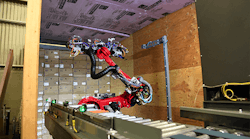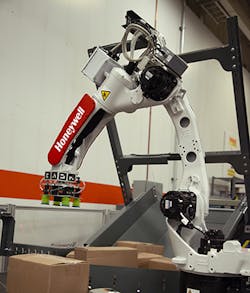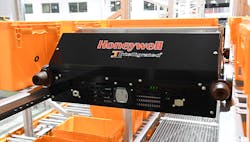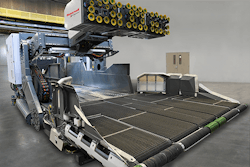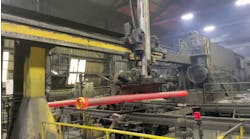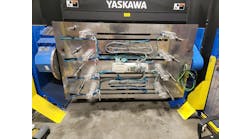Dr. Thomas Evans is robotics chief technology officer at Honeywell Safety and Productivity Solutions.
What sorts of sensing technologies have improved the effectiveness and reliability of picking systems and conveyance systems?
Dr. Thomas Evans, robotics chief technology officer, Honeywell Safety and Productivity Solutions: In the most traditional order-fulfillment and picking applications, workers travel on foot from line item to line item to fulfill orders. The travel of the employee can take up to 50% of the picker’s total time during the workday. Two approaches to reduce the travel time and increase operational rates include leveraging autonomous mobile robotics (AMRs) through assisted- and zone-picking solutions or shuttling the goods to an employee in a picking station via an AS/RS goods-to-person (GTP) or goods-to-robot (GTR) fulfillment process.
Also read: Warehouses continue to improve efficiency with collaborative robots, AMRs and AGV technology
In AMR applications, advanced sensing of LiDAR, high resolution cameras and range sensing, combined with sensor fusion schemes enable navigation and collision avoidance when traveling to each item and employee locations to fulfill orders. AMR navigation combined with pick-to-light and voice-command-guided work is effective in increasing reliability and efficiency of picking applications.
In an AS/RS GTR solution, advanced sensing is required to enable robotic picking solutions for order fulfillment. GTR operations autonomously identify the order items in totes through computer vision algorithms and then command the robot to intricately pick and place the item in the order bin or box. Machine learning and AI-based approaches to build knowledge of how to properly detect and position the robot and picking tool in the optimal position and orientation can increase reliability and effectiveness of the computer vision. In addition, emerging sensing technologies like tactile sensing and optical sensing at the tool level can assist in providing sensor feedback of a successful pick and transport of items without drops or product damage.
As warehouse distribution centers continue to grow larger, how are tracking and intelligence helping to keep up with customer demands?
Dr. Thomas Evans, robotics chief technology officer, Honeywell Safety and Productivity Solutions: Many distribution centers (DCs) still rely on traditional allocation strategies to keep pace with increasing demands, such as first in/first out (FIFO), first expired/first out and minimizing touches. While these techniques can offer some relief, they’re not sufficient to handle today’s challenges on their own.
Warehouse execution systems now leverage machine-learning algorithms and artificial intelligence (AI) to make intelligent storage and retrieval decisions that optimize automated systems to meet throughput and system responsiveness goals. Machine learning and AI techniques give businesses an intelligent set of tools for maximizing the effectiveness of AS/RS shuttle and GTP/GTR station processes.
Figure 2: Warehouse robotics can offer speed, accuracy, reliability and consistency at scale.
Warehouse execution system (WES) software improves AS/RS optimization by:
- boosting throughput
- increasing storage density
- prioritizing customer service-level agreements (SLAs)
- reducing congestion
- smart inventory replenishment.
Cloud computing, computer vision and machine learning are just a few of the technologies that give robots the sensing and cognition to autonomously solve the complexities of operating in distribution centers and warehouses (Figure 1). Armed with the appropriate sensors, algorithms and data links—as well as human operators who can remotely troubleshoot the operation—warehouse robotics can offer speed, accuracy, reliability and consistency at scale (Figure 2).
Which technologies have allowed warehouses to increase throughput rates while expanding product ranges and still maintaining accurate order fulfillment?
Dr. Thomas Evans, robotics chief technology officer, Honeywell Safety and Productivity Solutions: Growing inventories, lack of available real estate, the cost of facility expansion and labor pressures are all pushing operations to make the most efficient use of their existing workspaces. There are several next-generation technologies available to maintain customer service levels while expanding product ranges.
High-volume ecommerce fulfillment operations can leverage AS/RS shuttle and GTP station configuration to automate traditionally labor-intensive order picking tasks. In this highly efficient workflow, shuttles pull totes from inventory racks, route them via vertical lifts and aisles to conveyors and deliver them to a GTP station operator.
Machine learning can help further increase throughput at the stations and reduce order cycle time. Machine learning and AI help by considering how demand/orders are allocated and assigned to the stations, along with factors like the operator’s rate of picking, shipping cut-off requirements and congestion at each station.
Traditional person-to-goods picking processes require workers to travel throughout picking zones to build orders. Manual retrieval is both inefficient and costly; foot travel alone can take up to half of a picker’s total time. Using this method, even the most efficient operations struggle to achieve the required throughput rates needed to meet their customer service-level agreements (SLAs).
AS/RS shuttles with integrated GTP stations resolve this dilemma. Instead of workers traveling long distances through pick modules or even driving forklifts across a DC, an AS/RS shuttle pulls totes from multi-aisle and multi-level storage racks, routes goods to vertical lifts and conveyors and then delivers them to workers at designated GTP stations. Ergonomically designed to support top-down, pick-and-place workflows, these plug-and-play GTP stations enable high-speed, scalable order-fulfillment capabilities. Using this method, pickers can remain in a single location and simply pull from totes to efficiently build and pack out customer orders.
Because of the warehouse’s physical nature, how much of the facility’s hardware can be replaced with software in order to facilitate easier upgrades, expansions and reconfigurations?
Dr. Thomas Evans, robotics chief technology officer, Honeywell Safety and Productivity Solutions: The hardware inside a warehouse’s four walls must be able to be optimized with software to keep workflows running smoothly. For example, a key enabler of Honeywell Robotics’ AS/RS shuttle and GTP solution is the seamless integration with the warehouse execution system (WES). Empowered by the data science engine, the WES precisely orchestrates the movement of totes within the AS/RS, provides smart allocation and GTP station assignment, and enables dynamic storage capabilities that match available space with incoming inventory size and shape attributes.
The WES with the data science engine evaluates incoming ecommerce and store-replenishment orders and determines the most optimal sequencing and buffering within the AS/RS. Orders are intelligently queued and released—considering storage locations, GTP station availability, travel routes and order priorities—to ensure fast, accurate and efficient fulfillment workflows. Applying decisional intelligence results in increased throughput rates, optimized resource utilization and maximum order-fulfillment efficiency.
Figure 3: While the impacts of AS/RS are immediate, many operations lack the tools to effectively manage its complexities or maximize its benefits.
How have automated storage and retrieval systems' roles changed over the past 10 years?
Dr. Thomas Evans, robotics chief technology officer, Honeywell Safety and Productivity Solutions: Modern distribution and fulfillment operations are adopting automated storage and retrieval system shuttles to address a variety of ecommerce challenges: labor costs and shortages, maximizing the utilization of existing facilities to avoid expansion costs and boosting throughput. While the impacts of AS/RS are immediate, many operations lack the tools to effectively manage its complexities or maximize its benefits (Figure 3).
AS/RS shuttles address some of the most critical market factors facing modern distribution and fulfillment operations, including labor shortages and rising wages, exponential SKU proliferation, shrinking delivery times and high order volumes and rising warehouse and construction costs.
Not only do AS/RS shuttles maximize the utilization of existing facilities and enable much higher throughput for orders, but they are particularly efficient for smaller orders containing a single item or just a few. This enhances the ability to meet increasingly demanding order-fulfillment requirements with shorter cycle times.
Figure 4: In a fully automated DC of the future, when products arrive at the loading dock, AMRs drive themselves into the trailer to detect and locate cargo, be it free or palletized packages.
Will autonomous mobile robots replace automated guided vehicles altogether, or is there room for both, based on the application or complementary functions?
Dr. Thomas Evans, robotics chief technology officer, Honeywell Safety and Productivity Solutions: There’s room for both autonomous mobile robots (AMRs) and automated guided vehicles (AGVs) to work together to make DCs more productive and efficient. In a fully automated DC of the future, when products arrive at the loading dock, AMRs drive themselves into the trailer to detect and locate cargo, be it free or palletized packages (Figure 4). They then scan product to determine what it is and where it needs to go next.
Driverless robots that operate as a forklift or pallet conveying system transport the palleted stacks of product to a station with a large robotic arm and conveyor system. This robot uses advanced computer algorithms to see each box in the stack and systematically pick and place it onto the conveyor for transportation throughout the center and to organize the product for shipment to its destination. In instances where the product received at the center outpaces the outbound shipments, advanced storage systems move product by railed bots.
Those systems span from floor to ceiling while the bots travel horizontally and vertically to grid locations. They stash product until an order is placed and then retrieve it when a consumer or store beckons.
Given the extraordinary percentage of manual operation in most distribution centers, will the 24/7 fully autonomous warehouse order-fulfillment center ever become commonplace?
Dr. Thomas Evans, robotics chief technology officer, Honeywell Safety and Productivity Solutions: Autonomous robotic operations are extremely complex, and warehouses and distribution centers are rapidly moving, evolving, chaotic, noisy and dynamic through seasonality changes and operational peaks. Adding to the complexity, a fully autonomous warehouse order-fulfillment center would remove all human supervision, remote intervention or teleoperation capabilities and rely only on robotics, automation hardware, sensing, algorithms and intelligence models to adapt; that’s a daunting challenge.
Advanced technology, computing, sensing and communications are all enabling higher-level intelligence gains for operational accuracy in autonomous architectures. An entire operational DC might not be possible soon, but the pressure to automate and solve for labor shortages and elevated ecommerce demand is accelerating foundational technology developments. These developments will certainly increase autonomous-system applications in distribution and fulfillment operations, and we’ll continue to see an increasing percentage of manual operations trending toward automation.
